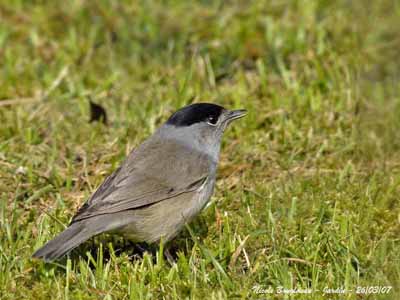
Eurasian Blackcap
Sylvia atricapilla
Passeriforme Order – Sylviidae Family
BIOMETRICS :
Length : 13-14 cm
Wingspan : 20-23 cm
Weight : 16-25 g
DESCRIPTION:
The Eurasian Blackcap is a medium-sized warbler very common in its range.

Adult male has grey-brown upperparts, including wings and tail which are slightly darker.
Underparts are pale grey.
Head is pale grey with black cap. The thin, straight bill has blackish culmen and tip. Eyes are dark brown with dark grey eye-ring above and white below. Legs and feet are grey.
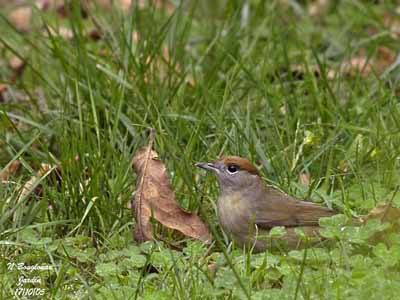
Female shows the same pattern but she has rufous-brown cap.
Upperparts are more brownish olive than grey, and underparts are pale buff-grey
The eye-ring is rufous-brown above and white below.
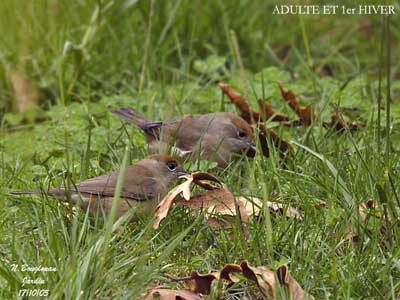
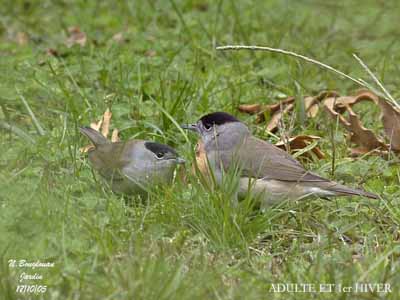
Juvenile resembles female with pale buffy-brown upperparts. The crown is duller, less contrasting. Eyes are dark grey.
The first winter is similar to each adult.
We can find five subspecies which differ in colour intensity.
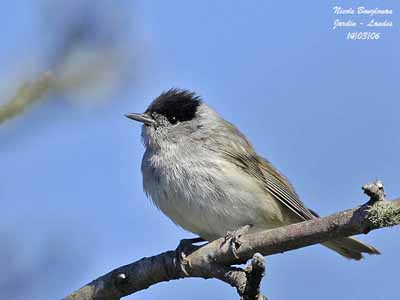
VOICE:
The Eurasian Blackcap utters sharp, loud “tak” as contact call, similar to the noise produced by two pebbles stuck together. Alarm call is a “churr”.
The beautiful song is a pure warbling, loud and rich. It is a melodious warble, rising and falling towards the end, finishing with a flourish of clear fluting notes.
The male may incorporate some mimicry of other birds’ species.
HABITAT:
The Eurasian Blackcap frequents mainly forests and any kind of forested and wooded areas. It also may be found in parks and gardens, orchards, evergreen forests or coniferous woodlands.
This species is present from sea-level to tree-line, up to 1600 to 2200 metres of elevation according to the range, but usually at about 500 metres.
In winter, it frequents bushy areas where it finds berries and fruits, urban gardens and olive groves.
The availability of fruits and berries influences their seasonal movements.
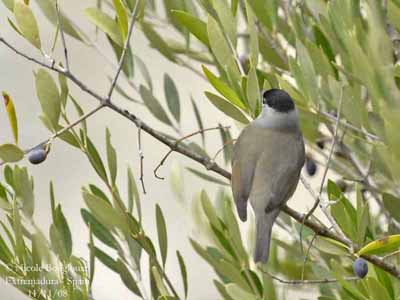
RANGE:
The Eurasian Blackcap is found in Eurasia, eastwards to Siberia, in northern Iran, North Africa and Atlantic Islands.
This species winters in Mediterranean regions and Africa until Tanzania.
BEHAVIOUR:
The Eurasian Blackcap frequents bird-feeders in winter, where it may be very aggressive and dominant. The bird puffs out its plumage to appear larger.
Blackcap feeds mainly on insects during the breeding season, but in autumn and winter, it feeds on berries and fruits, and olives in Mediterranean regions.
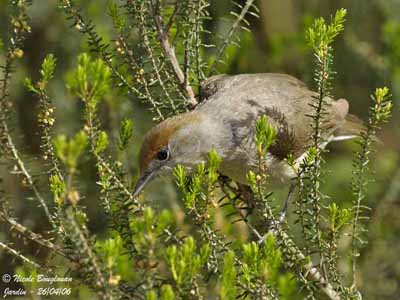
This bird forages at medium and high levels, gleaning the food from leaves and twigs. It swallows the small fruits and berries whole, but it pecks at pulp of larger items. It may hovers when feeding. It is rarely seen on the ground for fallen fruits. It is a very active bird.
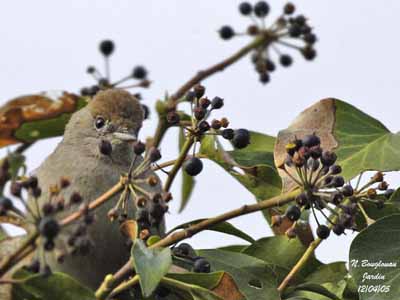
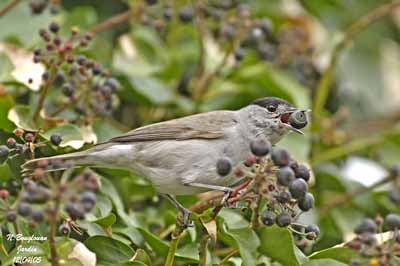
When the breeding season starts, the male builds several drafts of nests with dry grasses and rootlets between two branches, up to 3 metres above the ground. When the female arrives at breeding areas, sometimes she does not want any nest and she builds a new one, or completes one of the drafts by lining the interior with down and wool.
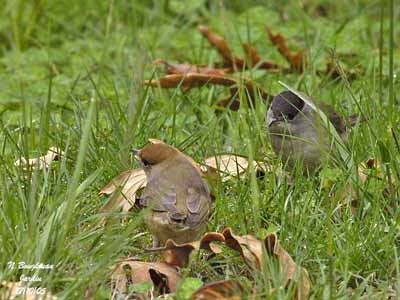
In the sedentary birds, courtship displays start very soon with males fighting and chasing each other in the low branches, while they give guttural notes. They puff out their feathers, the wings are dropped and the tail is alternatively fanned and closed while the dominant male erects its black crown feathers and establishes its territory.
The Eurasian Blackcaps living on Atlantic and Mediterranean islands are sedentary. Populations of Mediterranean Basin and some parts of Western Europe are partially migratory. In the northern and eastern parts of the range, some populations are long distance migrants. They travel singly or in loose groups, and may cover up to 200 km per night.
The fidelity to the breeding grounds is high and most of birds return to their natal territories.
FLIGHT:
Blackcap has undulating flight when flying over some distance. From tree to tree, it performs jerky flight.
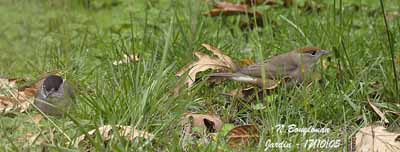
REPRODUCTION:
Breeding season occurs between mid-April and August in most parts of the range.
Nest is situated in low vegetation, in dense foliage of shrub or bush, or in small tree. It is a loose structure initiated by the male and finally, both mates complete or build a new nest. It is cup-shaped, made with twigs, grasses and rootlets. Interior is lined with fine grass and hair. It is placed between 80 cm and 2 metres above the ground.
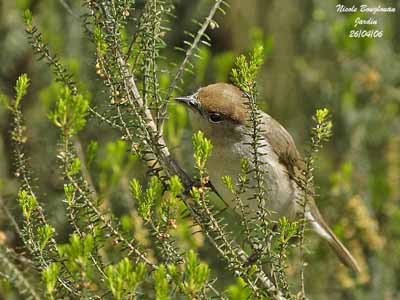
Female lays 3-5 pale grey-brown eggs, heavily spotted dark brown. Incubation lasts about two weeks by both parents, but mainly by female. Altricial chicks are fed by both parents and fledge about 10-15 days after hatching. Parents care them for 2-3 weeks more.
This species usually produces two broods per year.
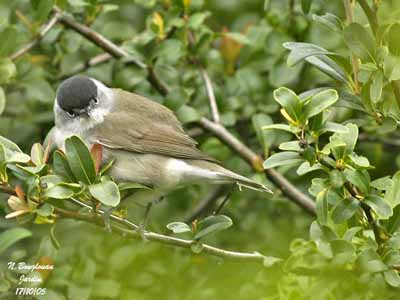
DIET:
The Eurasian Blackcap feeds on insects and larvae during the breeding season, but this bird feeds mainly on fruits and berries in rest of the year.
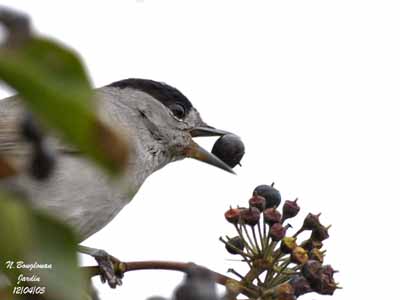

PROTECTION / THREATS / STATUS:
The Eurasian Blackcap is common in most parts of the range, and has adapted to urban and suburban areas.
This species is not globally threatened at this moment.
Fr : Fauvette à tête noire
All : Mönchsgrasmücke
Esp : Curruca Capirotada
Ital : Capinera
Nd: Zwartkop
Russe: Черноголовая славка
Sd: Svarthätta
Photographs and text by Nicole Bouglouan
Sources:
HANDBOOK OF THE BIRDS OF THE WORLD Vol 11 by Josep del Hoyo, Andrew Elliott and David Christie - Lynx Edicions - ISBN: 849655306X
THE HANDBOOK OF BIRD IDENTIFICATION FOR EUROPE AND THE WESTERN PALEARCTIC by Mark Beaman, Steve Madge - C.Helm - ISBN: 0713639601
THE COMPLETE BOOK OF BRITISH BIRDS – Written by “Royal Society for the Protection of Birds” experts - Préface de Magnus Magnusson - Michael Cady- Rob Hume Editors - ISBN: 0749509112
L’ENCYCLOPEDIE MONDIALE DES OISEAUX - Dr Christopher M. Perrins - BORDAS - ISBN: 2040185607
Pájaros de España (JL Beamonte)